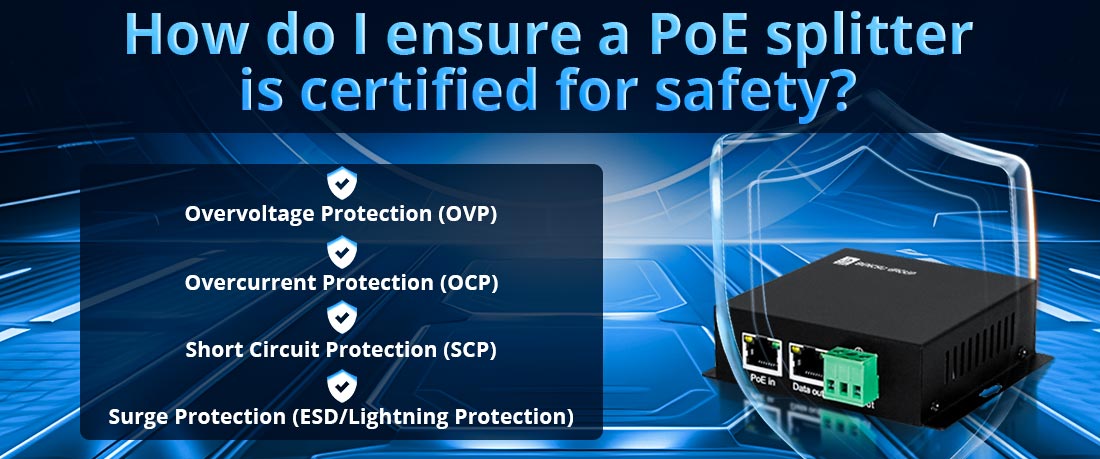
يفصل فاصل POE (Power Over Ethernet) الطاقة والبيانات عن كبل Ethernet ، مما يوفر طاقة DC لجهاز غير بوي. نظرًا لأنه يتعامل مع الطاقة الكهربائية ، فإن ضمان تلبية معايير السلامة وإصدار الشهادات أمر بالغ الأهمية لتجنب المخاطر الكهربائية أو تلف الجهاز أو فشل الشبكة.
1. ابحث عن شهادات سلامة الصناعة
يجب أن يكون لدى فاصل POE عالي الجودة شهادات السلامة من منظمات المعايير المعترف بها. فيما يلي أهم الشهادات التي يجب البحث عنها:
A. IEEE 802.3 معايير (امتثال POE)
--- IEEE 802.3AF (POE)-حتى 15.4W
--- IEEE 802.3at (POE+)-حتى 30W
--- IEEE 802.3BT (Poe ++/4ppoe) - ما يصل إلى 60 واط أو 90 واط
يضمن أن يجتمع الصخور معايير الجهد ، توصيل الطاقة ، ومعايير الكفاءة لأجهزة POE.
كيفية التحقق: يجب سرد الشهادة في ورقة بيانات المنتج أو وضع العلامات.
شهادة ب.
--- UL 60950-1: سلامة معدات تكنولوجيا المعلومات والاتصالات (المعيار الأقدم).
--- UL 62368-1: أحدث معيار أمان لأجهزة الطاقة والشبكات.
كيفية التحقق: ابحث عن علامات "UL المدرجة" أو "UL المعترف بها" على الخائن أو العبوة.
C. CE (Contormité Européenne) Mark (لأوروبا)
--- يشير إلى الامتثال لقوانين السلامة والصحة وحماية البيئة في الاتحاد الأوروبي.
--- يضمن انخفاض التدخل الكهرومغناطيسي (EMI) ومعالجة الطاقة الآمنة.
--- كيفية التحقق: يجب أن تكون علامة CE على ملصق الجهاز أو ورقة البيانات.
شهادة د. لجنة الاتصالات الفيدرالية (لجنة الاتصالات الفيدرالية) (للولايات المتحدة)
--- يضمن توافق فاصل POE مع حدود التداخل الكهرومغناطيسي (EMI) لمعدات تكنولوجيا المعلومات.
--- كيفية التحقق: يجب أن يذكر وصف المنتج الامتثال لجزء 15.
E. ROHS (تقييد المواد الخطرة) الامتثال
--- يضمن أن يكون الجهاز خاليًا من مواد سامة مثل الرصاص والزئبق والكادميوم.
--- مهم للعملية الصديقة للبيئة وآمنة.
--- كيفية التحقق من: يجب أن تُطلق عليها اسم Poe Splitter على أنها "متوافقة مع ROHS".
F. Tüv (Technischer überwachungsverein) شهادة (لألمانيا)
--- يشير إلى أن الجهاز يلبي معايير السلامة الألمانية للمعدات الكهربائية والإلكترونية.
ج.
--- يضمن الامتثال لقانون الأجهزة الكهربائية في اليابان وسلامة المواد.
2. تحقق من الشركة المصنعة ووثائق المنتج
--- أوراق البيانات والأدلة الرسمية: توفر العلامات التجارية ذات السمعة الطيبة أوراق بيانات تقنية مفصلة تسرد ميزات وشهادات السلامة.
--- تسميات المنتج: سيكون لدى Poe Splitters معتمد شعارات من شهادات السلامة على المنتج أو العبوة.
--- موقع الشركة المصنعة: تحقق من الموقع الرسمي للعلامة التجارية للحصول على تفاصيل الشهادة.
3. ابحث عن ميزات السلامة المدمجة
حتى إذا تم اعتماد فاصل Poe ، فيجب أن يكون لديه حماية سلامة مدمجة لضمان تشغيل آمن:
--- حماية الجهد الزائد (OVP): يمنع الجهد المفرط من الأجهزة المتصلة الضارة.
--- حماية التيار الزائد (OCP): يتم إيقاف تشغيله إذا تجاوزت الطاقة الحد الأقصى.
--- حماية الدائرة القصيرة (SCP): يمنع الأضرار في حالة وجود خطأ في الأسلاك.
--- حماية الطفرة (حماية ESD/Lightning): يحمي من الطغات الكهربائية والتفريغ الثابت.
4. تجنب المنتجات المزيفة أو غير المؤقتة
علامات تحذير غير آمنة Poe Splitters:
--- لا توجد شهادات السلامة المدرجة في وصف المنتج.
--- العلامات التجارية العامة أو التي لا تسام تفتقر إلى الشفافية.
--- أسعار منخفضة بشكل مثير للريبة مقارنة بالعلامات التجارية ذات السمعة الطيبة.
--- لا يوجد موقع رسمي أو مراجعات العملاء.
لضمان الأصالة:
--- شراء من العلامات التجارية ذات السمعة الطيبة والموزعين المعتمدين.
--- تحقق من أرقام الشهادات على مواقع السلامة الرسمية (على سبيل المثال ، قاعدة بيانات UL).
5. الخلاصة: ضمان شهادة بوي معتمدة للسلامة
--- ابحث عن امتثال IEEE 802.3AF/AT/BT لضمان تشغيل POE المناسب.
--- تحقق من شهادات UL و CE و FCC و ROHS وشهادات السلامة الأخرى.
--- مراجعة ورقة البيانات والشركة المصنعة لمعلومات الامتثال.
--- اختر فاصل Poe مع الجهد الزائد المدمج ، والتواصل الزائد ، وحماية الطفرة.
--- شراء من العلامات التجارية الموثوقة والبائعين المعتمدين لتجنب المنتجات المزيفة.
يضمن استخدام فاصل POE معتمد توصيل الطاقة الآمن ، ويحمي الأجهزة ، ويمنع المخاطر الكهربائية.